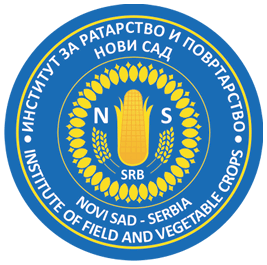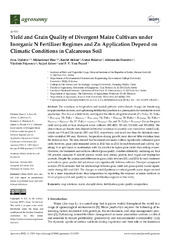Приказ основних података о документу
Yield and Grain Quality of Divergent Maize Cultivars under Inorganic N Fertilizer Regimes and Zn Application Depend on Climatic Conditions in Calcareous Soil
| dc.creator | Đalović, Ivica | |
| dc.creator | Riaz, Muhammad | |
| dc.creator | Akhtar, Kashif | |
| dc.creator | Bekavac, Goran | |
| dc.creator | Paunović, Aleksandar | |
| dc.creator | Pejanović, Vladimir | |
| dc.creator | Zaheer, Sajjad | |
| dc.creator | Prasad, Vara | |
| dc.date.accessioned | 2022-11-01T07:21:57Z | |
| dc.date.available | 2022-11-01T07:21:57Z | |
| dc.date.issued | 2022 | |
| dc.identifier.issn | 2073-4395 | |
| dc.identifier.uri | http://fiver.ifvcns.rs/handle/123456789/3205 | |
| dc.description.abstract | The variations in temperature and rainfall patterns under climate change are threatening crop production systems, and optimizing fertilization practices is a prerequisite for sustainable cereal production. This two‐year field study investigated the effects of eight treatments (T1: P60K60; T2: P60K60 + Nmin spring; T3: P60K60 + N40autumn + Nmin spring; T4: P60K60 + N60spring; T5: P60K60 + N100spring; T6: P60K60 + N40autumn + N60spring + Zn; T7: P60K60 + N60autumn + N80spring + Zn; and T8: P60K60 + N160spring + Zn) on the grain yield and quality of four divergent maize cultivars (NS‐4023, NS‐640, NS‐6010 and NS‐6030). The observations on climatic data showed substantial variations in monthly and cumulative rainfall only, which was 174 and 226 mm for 2011 and 2012, respectively, and much less than the historical cumulative rainfall of 339 mm. However, temperature during growth years showed little deviation from the historical data. The data showed that treatment and maize cultivar significantly influenced grain yield; however, grain yield remained lower in 2012 than in 2011 for each treatment and cultivar. Applying N as split doses in combination with Zn, resulted in higher grain yields than adding at once. However, the treatments and cultivars affected grain quality variables differently, including oil, thiol SH, phytate, inorganic P, soluble protein, starch, total phenol, protein, total sugars and tryptophan contents. Despite the pronounced difference in grain yields between 2011 and 2012 for each treatment and cultivar, grain quality did not always vary significantly between cultivars. Principal component analysis (PCA) revealed that the relationships between grain yield and grain quality varied significantly during 2011 and 2012. The changes in rainfall patterns at critical growth maize stages seemed to be a more important factor than temperature in regulating the response of maize cultivars in terms of grain yield and quality to various fertilization regimes in this study. | sr |
| dc.language.iso | en | sr |
| dc.publisher | Basel : MDPI | sr |
| dc.relation | info:eu-repo/grantAgreement/MESTD/inst-2020/200032/RS// | sr |
| dc.rights | openAccess | sr |
| dc.rights.uri | https://creativecommons.org/licenses/by/4.0/ | |
| dc.source | Agronomy - Basel | sr |
| dc.subject | crop rotation | sr |
| dc.subject | maize | sr |
| dc.subject | drought stress | sr |
| dc.subject | fertilization | sr |
| dc.subject | grain quality | sr |
| dc.subject | grain quality composition | sr |
| dc.subject | cultivars | sr |
| dc.subject | calcareous soils | sr |
| dc.subject | zinc | sr |
| dc.subject | Zn | sr |
| dc.subject | inorganic N fertilizer | sr |
| dc.subject | yield | sr |
| dc.title | Yield and Grain Quality of Divergent Maize Cultivars under Inorganic N Fertilizer Regimes and Zn Application Depend on Climatic Conditions in Calcareous Soil | sr |
| dc.type | article | sr |
| dc.rights.license | BY | sr |
| dc.citation.rank | M21 | |
| dc.citation.spage | 2705 | |
| dc.citation.volume | 12 | |
| dc.identifier.doi | 10.3390/agronomy12112705 | |
| dc.identifier.fulltext | http://fiver.ifvcns.rs/bitstream/id/9011/bitstream_9011.pdf | |
| dc.identifier.scopus | 2-s2.0-85141678325 | |
| dc.type.version | publishedVersion | sr |


